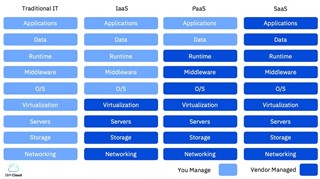Cumulus, Stratus, Cirrus….no…not that THAT kind of CLOUDY.
The increasing number of cloud options can be confusing. With that in mind, I thought I’d ‘clear the air’ and review some of the more popular implementations.
There are literally hundreds of companies providing cloud services with different areas of focus.
Have a look…
https://www.forbes.com/cloud100/list/
…..but to simplify, I thought I would review offerings from two technology giants,
Microsoft and Amazon. These will be detailed in Part 2 and Part 3.
In this Part 1 of the series, the 'aaS' concept is covered.
'aaS' is an acronym for "as-a-service" as it relates to cloud computing.
There are lots of these too...
|
Service |
Abbr. |
|
AnaaS |
|
|
AaaS |
|
|
AIaaS |
|
|
BaaS |
|
|
BPaaS |
|
|
CIaaS |
|
|
CaaS |
|
|
CPaaS |
|
|
DaaS |
|
|
Desktop as a service |
|
|
Drone as a service |
|
|
DBaaS |
|
|
Distribution as a service |
DaaS |
|
EaaS |
|
|
ESaaS |
|
|
Electric vehicle as a service [2] |
EVaaS |
|
FaaS |
|
|
GaaS |
|
|
Hadoop as a service |
HaaS |
|
Housing as a service |
|
|
IaaS |
|
|
Identity as a service |
IDaaS |
|
KaaS |
|
|
LaaS |
|
|
MaaS |
|
|
Microgrid as a service |
|
|
MBaaS |
|
|
MLaaS |
|
|
NaaS |
|
|
NDaaS |
|
|
PaaS |
|
|
RAN as a service |
|
|
RaaS |
|
|
SaaS |
|
|
TaaS |
|
|
UCaaS |
For the purposes of this blog, IaaS, PaaS (DBaaS), and SaaS will be covered for context around database cloud deployments.
IBM has published a great at-a-glance understanding of what you manage versus what the vendor manages in these ’aaS' models
(Click on the image to enlarge)

IaaS – Infrastructure as a Service
The physical infrastructure is provided ‘as a service’. In my experience, this is often what companies dip their toe in the water with first. This is likely because IaaS provides among the lowest-level control of resources in the cloud. I say ‘among’ because though less popular, there is the option of BMaaS – Bare-Metal-as a-Service. This is direct access to the hardware as opposed to being provisioned virtualized compute, network, and storage. With an IaaS model, the service manages the infrastructure (for a fee) and users purchase, configure and manage the software like the operating systems, middleware, and applications. For DBAs, this equates to installing the DBMS on a VM and implementing it in the cloud.
Advantages:
- Nimble/on-demand growth and scaling (up or down) without the need for hardware investment spend or increased IT staffing and training.
- (Potential) cost savings by the reduction in hardware (and again, staffing) spend. This needs to be weighed versus IaaS subscription costs.
- Accessibility is typically improved as users can get to what they want, where they want
Disadvantages:
- Reliance - If something goes down on the provider end, all you can do is wait...or scramble back to the on-prem option. Uptime and productivity are not only at risk but also out of your hands.
- Security - Systems can be exposed and be vulnerable to hacking.
PaaS – Platform-as-a-Service
In the database world, we hear about DBaaS – Database-as-a-Service, a more specific type of PaaS. Also offered as a fee-based subscription, the provider maintains the physical infrastructure and the database …and delivers it as a private cloud service. With DBaaS, subscribers reap the benefit of forgoing several administrative tasks. The end-user controls database content and usage. Time to value is improved but inherently, it offers less flexibility and control.
Advantages:
- No need to build, configure, and/or maintain your DBMSs.
- Database bugs, patches, upgrades, and general uptime are maintained
- Little need for Database Development/Developers
Disadvantages:
- Reduced security control
- Little to no customizations to your database implementations
SaaS – Software-as-a-Service
Software applications are delivered ‘on-demand’ via the cloud provider versus local platform deployments. With an internet connection and a web browser, users access the software deployed in the cloud. There is no need to install, manage, or maintain anything.
Here is a blog I wrote describing SaaS benefits.
Consider a SaaS Solution: https://www.quest.com/community/blogs/b/performance-monitoring/posts/saasy-consider-software-as-a-service
Bonus: Serverless computing!
It is called 'serverless' even though physical servers are used. In this model, instead of paying for a fixed amount of resources, the service 'auto-scales'. Users are charged 'as-used'. This eliminates the need to determine the size and scope of the infrastructure required and reserved.
Every company has different needs, priorities, budgets, and resources so understanding the benefits and shortcomings of each configuration is important.
The market for these technologies is growing and evolving at a rapid pace. As such, there are more and more vendor ‘flavors’ available.
In part 2 (of 3) of this blog series, I will review some of the Microsoft Azure derivations.
Sources:
forbes.com
horsesforsources.com
ibm.com
cloudflare.com
objectrocket.com
wikipedia.com



-

dmshubham sharma
over 3 years ago
-
Cancel
-
Up
0
Down
-
-
Reply
-
More
-
Cancel
Comment-

dmshubham sharma
over 3 years ago
-
Cancel
-
Up
0
Down
-
-
Reply
-
More
-
Cancel
Children